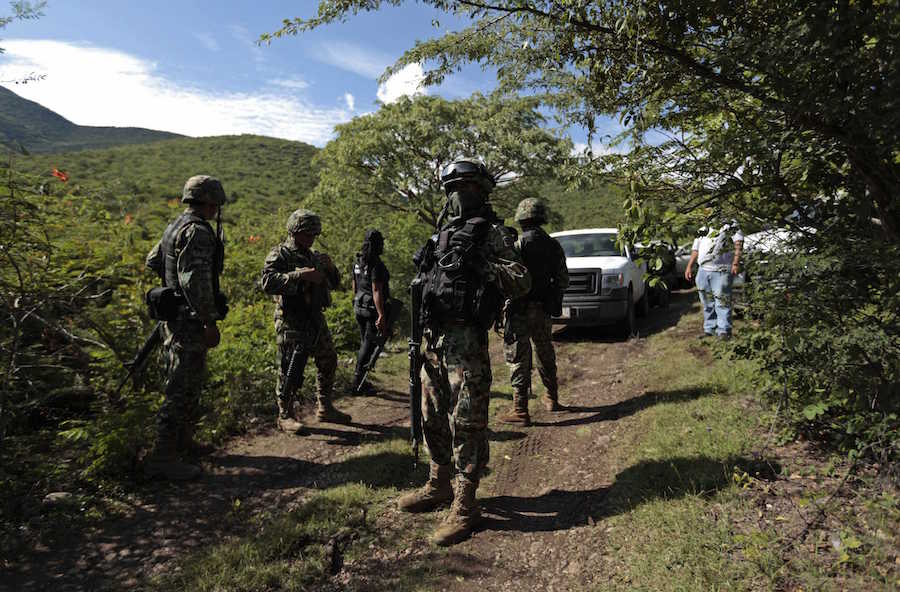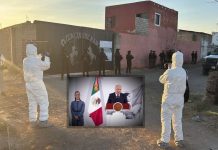Soldiers guard an area where a mass grave was found, in Colonia las Parotas on the outskirts of Iguala, in Guerrero October 4, 2014. Authorities found the mass grave in the restive southern Mexican state of Guerrero (REUTERS/Jorge Dan Lopez)
US: Mexico Mass Graves Raise «Alarming Questions» about Government «Complicity» in September 2014 Cartel Killings
Washington, DC, May 12, 2015 – A U.S. military “Human Rights Working Group” said that mass graves not related to the September 2014 disappearance of 43 students in Guerrero, Mexico—but nevertheless found during the investigation of that case—raised “alarming questions” about the “level of government complicity” in Mexican cartel killings. The student victims from a rural teachers college in Ayotzinapa were allegedly abducted by local police forces and turned over to members of a local drug gang to be executed. All but one of the students—whose remains were reportedly identified by an Austrian forensic group—are still missing seven months later.
The October 2014 report from U.S. Northern Command (NORTHCOM) is one of several declassified records obtained by the nongovernmental National Security Archive and highlighted in a new report for The Intercept by former Archive staffer Jesse Franzblau and Cora Currier. The newly-declassified records, some posted here for the first time, shed light on how the U.S. has perceived and responded to allegations of serious human rights abuses committed by U.S.-funded security forces in Mexico, which have become disturbingly common in recent years.
“None of the 28 bodies identified thus far are the remains of the students,” reads a summary of the Working Group meeting circulated to senior officers at NORTHCOM on October 14, 2014, “raising alarming questions about the widespread nature of cartel violence in the region and the level of government complicity.” NORTHCOM, based in Colorado, is the regional military command in charge of Defense Department programs in the United States, Canada and Mexico.
Another item on the Working Group’s agenda was the June 2014 slaying of 22 suspected drug gang members at Tlatlaya, in the state of Mexico, by the Mexican Army’s 102nd Battalion. Four months later, and shortly after the arrests of a Mexican Army officer and seven soldiers from the 102nd for the killings and subsequent cover up, the Working Group “assesse[d] that as more facts come to light there is greater acceptance that the military was involved in wrongdoing,” raising serious questions about the ability of the U.S. to provide aid to military forces in the region.
“If [the military zone commander is] implicated in a gross human rights violation,” the Working Group reported, “the entire military zone and 10,000 personnel will be ineligible for U.S. security cooperation assistance.”
Another NORTHCOM document obtained by the Archive and highlighted in the report is the first public confirmation that the U.S. State Department last year did quietly suspend assistance to the 102nd Battalion following Tlatlaya, pending the outcome of official investigations. The NORTHCOM “Information Paper on San Pedro Limon, Tlatlaya Incident” indicates that the 102nd “is now ineligible to receive US assistance.”
Questioned about the reported suspension of aid by The Intercept, the State Department would only confirm that five members of the battalion had previously been trained by the U.S. but said that none of those five are implicated in the Tlatlaya case. A 1997 law introduced by Senator Patrick Leahy (D-Vt.) bars U.S. support to foreign security forces credibly linked to human rights violations.
Franzblau and Currier call the suspension of aid in the Tlatlaya case “a rare confirmed example of the U.S. government actually cutting off funding for security forces” in Mexico. Even so, the State Department has not said whether any Mexican units tied to the Guerrero disappearances have been declared ineligible for U.S. aid, as the Leahy law would seem to require in this case.
According to the authors, “The State Department’s piecemeal response to these events highlights the conundrum that Mexico now presents for the United States, as it seeks to help the Mexican government battle drug cartels.” The U.S. has provided some $3 billion in security assistance to Mexican forces since 2008, in addition to billions more in direct military sales and other aid.
Franzblau and Currier cite a diplomatic cable published by Wikileaks to “show how U.S.-Mexico security and intelligence relations have reached unparalleled levels of intimacy” in recent years. The 2010 cable from the U.S. Embassy in Mexico City stresses that U.S. “ties with the Military” at that time had “never been closer in terms of not only equipment transfers and training” but also “intelligence exchanges.”
But the unprecedented level of U.S. influence on Mexico’s armed forces came alongside an extraordinary increase in drug war abuses and in human rights violations connected to state and local security forces. The violence that has engulfed Mexico since then has produced a flurry of reports from U.S. diplomatic and intelligence officers expressing concern that America’s drug war partners in the Mexican security forces were working hand-in-glove with cartel terrorists.
• In April 2010, the U.S. Embassy’s Narcotics Affairs Section said that criminal groups operated with “near total impunity in the face of compromised local security forces.”
• An FBI report from later that year included a list of police officers in Saltillo, Coahuila, who had “provided support and information” to the notorious Los Zetas drug gang.
• In another case previously reported by the Archive, the U.S. had knowledge of Mexican government efforts to downplay the magnitude of the infamous 2011 San Fernando massacre, in which cartel thugs allied with local police forces kidnapped and murdered hundreds of migrants from intercity buses headed north toward the U.S.-Mexico border. Mexican officials, “speaking off the record,” also told the U.S. that the bodies of the massacre victims were “being split up to make the total number less obvious and thus less alarming.”
One of the key objectives of U.S. aid to Mexico during this time has been to beef up the country’s security communications infrastructure by lending funds, expertise and equipment to the Plataforma Mexico project, which the U.S. State Department describedin 2007 as a “billion-dollar scheme for establishing interconnections between all police and prosecutors.” The U.S. poured millions of dollars into Plataforma Mexico, which was essentially a criminal database that connected state- and regional-level intelligence coordination centers known as “C-4s” (“command, control, communications and coordiation”) to each other and to law enforcement officials through a centralized, U.S.-funded command and control facility known as “The Bunker.”
Franzblau and Currier point out that the “more sophisticated C-4s in Mexico’s northern region communicate directly with U.S. agencies, such as Department of Homeland Security offices across the border,” but there is good reason to question the overall effectiveness of the C-4s in combatting drug violence. A 2009 assessment said that neither Plataforma México nor the C-4 in San Pedro, in a suburban section of Monterrey, had been successful in hindering cartel operations. A declassified January 2010 cable from the U.S. Embassy in Mexico, for example, said that the C-4 facility in Tijuana was little more than a “glorified call center” for everyday emergencies that lacked “a strong analytical component.” Two months prior, a separate cable from the Embassy described a range of competency at the various C-4s, from, “at the low end, glorified emergency call centers,” to “[a]t the high end… more professional analytic cells that produce useful analysis and planning documents and also have a quick response time.”
The more complete C-4s include representatives from national and regional entities, and are the nerve centers for day-to-day information flow, intelligence, and directing operations in the state. They are often also the link to national databases, such as Plataforma Mexico. Huge disparities between state C-4s exist, but many states are working to move their units from merely housing emergency dispatchers to being functional hubs of operations and intelligence. The UNITOs [Tactical operational units, or Unidades Táctiva Oprerativo] often rely on information fed from good C-4s, in addition to federal databases and platforms.
Most importantly, as Franzblau and Currier note in their piece, the U.S.-funded C-4s also appear to have played a role in the disappearance of the 43 students in Guerrero:
C-4s certainly didn’t help in the case of the forty-three missing Ayotzinapa students. As The Intercept detailed, internal records produced by Guerrero state investigators show that the regional C-4s near the site of the students’ kidnapping transmitted information on the movement of the students the night that they were attacked. But neither federal law enforcement nor the military intervened to stop the violence.
Reports in the Mexican magazine Proceso and elsewhere linking regional C-4s and other government entities to the events surrounding the Ayotzinapa case have led many to question what the government knew about the massacre and have galvanized calls in Mexico for greater openness about government efforts to bring cartel thugs and their collaborators in the security forces to justice. It remains unclear whether the U.S. will apply Leahy Law sanctions to the C-4 units that were apprently involved in the disappearance of the 43 students.
Mexican authorities have promised transparency but have largely resisted the efforts of journalists and academics to gain access to records on the cases. This despite the fact that Mexican law requires the release of information pertaining to grave violations of human rights in all cases. (In one notable exception, Mexico’s attorney general last year declassified a document from its case file on the 2011 San Fernando massacre showing that local police helped to round up hundreds of migrants later killed at the hands of the Zetas cartel.)
Mexican government stonewalling about the case has some looking to the U.S.—Mexico’s chief sponsor and partner in the anti-drug effort—for answers. A key part of the U.S. paper trail are records indicating how the U.S. government determines whether to suspend security assistance to members and units of the Mexican security forces involved in human rights abuses. One newly-declassified document shows that senior U.S. military officials from NORTHCOM reached out to counterparts from Mexico’s Defense Ministry (SEDENA) about the Tlatlaya killings after receiving multiple questions about the case.
“Since we’ve continued to get inquiries as to what we’ve specifically talked to SEDENA about ref. the Tlatlaya incident, I made a call to SEDENA Enlace,” reads an October 2014 message from the Pentagon official in charge of U.S. military assistance programs in Mexico (the Office of Defense Cooperation – ODC). Among other things, the ODC chief said it was “good news” to hear from SEDENA that alleged human rights cases like Tlatlaya are “taken out of the military justice system” and transferred to civilian authorities.
A 2014 law requires Mexico’s attorney general to prosecute all cases in which Mexican security forces are accused of abusing civilians. But as Franzblau and Currier point out, it is not at all clear that the civil justice system has been any more effective at punishing human rights violators than military tribunals:
A Mexican government database lists over 23,600 people who have been reported disappeared throughout the country; 2014 witnessed 5,133 disappearances, the highest number on record. Impunity remains the norm, with 98.3 [sic – should be 93.8]percent of crimes going unpunished in 2013, according to Mexican government statistics. The U.S. State Department’s own human rights reporting on Mexico highlights police and military involvement in serious abuses, including unlawful killings, physical abuse, torture and disappearances… The Mexican government’s failure to investigate mass graves provides a revealing example of the problem of impunity. Hundreds of mass graves have been discovered in Mexico in recent years. Despite that, Mexico’s federal prosecutors have reported opening just 15 investigations between 2011 and April 2015, according to documents obtained by the human rights organization Article 19.
There are no easy answers to the “alarming questions” raised by the shocking number of mass graves now being unearthed in Mexico. What seems clear is that a U.S. strategy that has poured billions of dollars into Mexico’s drug war over the last decade—mostly aimed at taking down high-profile cartel kingpins—has done little to stem epidemic levels of violence or limit the criminal groups’ ability to compromise government officials at all levels.
For more on this topic, check out Franzblau and Currier’s new article over at The Intercept.
The National Security Archive
Posted May 12, 2015
Edited by Michael Evans
For more information contact:
Michael Evans 202/994-7029, mevans@gwu.edu








